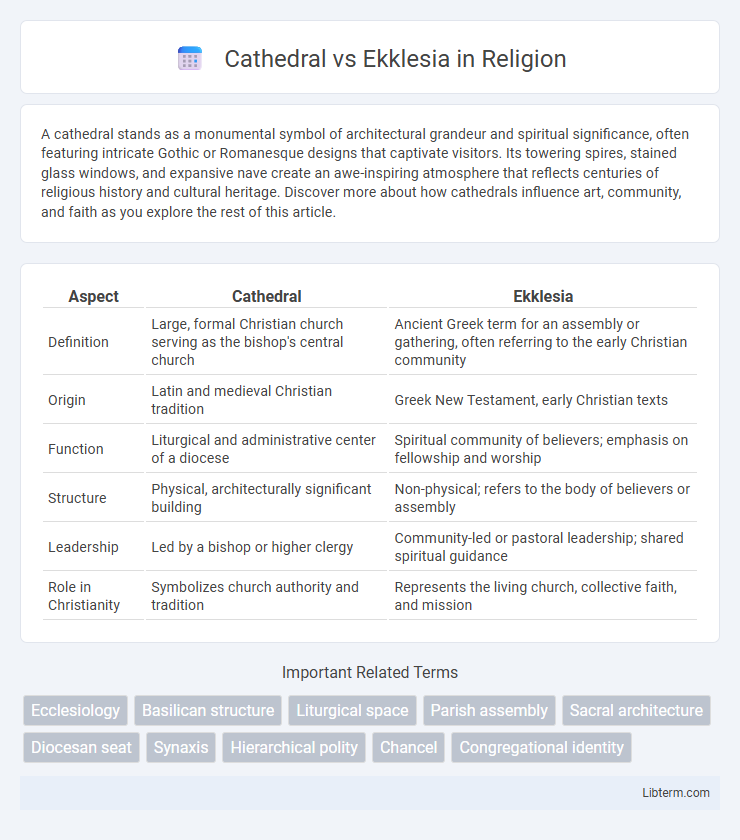A cathedral stands as a monumental symbol of architectural grandeur and spiritual significance, often featuring intricate Gothic or Romanesque designs that captivate visitors. Its towering spires, stained glass windows, and expansive nave create an awe-inspiring atmosphere that reflects centuries of religious history and cultural heritage. Discover more about how cathedrals influence art, community, and faith as you explore the rest of this article.
Table of Comparison
| Aspect | Cathedral | Ekklesia |
|---|---|---|
| Definition | Large, formal Christian church serving as the bishop's central church | Ancient Greek term for an assembly or gathering, often referring to the early Christian community |
| Origin | Latin and medieval Christian tradition | Greek New Testament, early Christian texts |
| Function | Liturgical and administrative center of a diocese | Spiritual community of believers; emphasis on fellowship and worship |
| Structure | Physical, architecturally significant building | Non-physical; refers to the body of believers or assembly |
| Leadership | Led by a bishop or higher clergy | Community-led or pastoral leadership; shared spiritual guidance |
| Role in Christianity | Symbolizes church authority and tradition | Represents the living church, collective faith, and mission |
Introduction to Cathedral and Ekklesia
The Cathedral represents a hierarchical, institutional form of church organization centered on centralized authority and structured worship spaces. Ekklesia refers to the original Greek term for a community of believers gathering for worship, emphasizing a decentralized, participatory fellowship without rigid institutional control. Understanding the distinction highlights contrasting models of church governance and community life in Christian theology.
Defining Cathedral: Architecture and Purpose
Cathedrals are monumental Christian churches serving as the principal church within a diocese, typically housing the bishop's seat known as the cathedra. Architecturally, cathedrals exhibit grand Gothic or Romanesque styles, characterized by vaulted ceilings, stained glass windows, and intricate stone carvings that symbolize religious narratives. Their primary purpose is to serve as central places of worship, ecclesiastical authority, and community gathering within a structured hierarchical church system.
Understanding Ekklesia: Origins and Meaning
Ekklesia originates from the Greek word ekklesia, historically referring to an assembly of citizens called out to gather for political decision-making in ancient Athens. Unlike the term Cathedral, which denotes a specific architectural structure serving as the principal church of a bishop's diocese, Ekklesia emphasizes the collective body of believers or the church community itself. This concept underscores a spiritual gathering focused on fellowship, worship, and communal governance rather than a physical building.
Historical Evolution of Cathedral and Ekklesia
The historical evolution of the cathedral reflects its role as a grand, centralized church serving as the bishop's seat in medieval Europe, symbolizing ecclesiastical authority and community gathering. Ekklesia, originating from the Greek term meaning "assembly" or "called-out ones," began as a concept of communal worship and fellowship among early Christian believers in the first centuries AD. Over time, Ekklesia evolved into the broader concept of the Christian church as both a spiritual and social institution, contrasting with the cathedral's physical and hierarchical significance.
Structural Differences between Cathedral and Ekklesia
A cathedral functions as the principal church within a diocese, housing the bishop's official seat, known as the cathedra, and typically features grand architectural designs with a cruciform layout and extensive stained glass. In contrast, an ekklesia originally refers to a gathering or assembly of believers rather than a physical building, often meeting in homes or simple structures without formal architectural features. Cathedrals emphasize hierarchical ecclesiastical authority and monumental construction, while ekklesia underscores communal worship and egalitarian assembly, reflecting differing structural and organizational principles.
Symbolic Significance in Christian Communities
The cathedral embodies the symbolic heart of Christian communities, representing ecclesiastical authority, architectural grandeur, and historical continuity, often serving as the central place for diocesan worship and major liturgical events. Ekklesia, rooted in the Greek word meaning "assembly" or "called-out ones," symbolizes the spiritual gathering of believers, emphasizing communal faith, shared worship, and the collective body of Christ beyond physical structures. This distinction highlights the cathedral as a tangible symbol of institutional Christianity, while ekklesia reflects the invisible, living church manifested through the fellowship and active participation of its members.
Liturgical Functions: Cathedral vs Ekklesia
The cathedral serves as the principal church of a diocese, housing the bishop's seat (cathedra) and hosting major liturgical functions such as ordinations, chrism masses, and diocesan celebrations. In contrast, an ekklesia refers to a local assembly or congregation where regular communal worship, Eucharistic celebrations, and sacramental activities occur within a parish context. Liturgical functions in cathedrals are often solemn, formal, and diocesan-wide events, while ekklesias emphasize local participation and pastoral care in everyday worship.
Cultural and Regional Variations
Cultural and regional variations significantly shape the distinctions between cathedral and ekklesia, with cathedrals often symbolizing centralized authority and hierarchical structure in Western Christianity, especially within Europe. Ekklesia, rooted in Greek tradition, commonly reflects a communal and participatory model of church, prevalent in Eastern Orthodox and early Christian communities. These variations highlight differing theological emphases and social functions, influencing architectural styles and worship practices across global Christian traditions.
Modern Perspectives on Cathedral and Ekklesia
Modern perspectives on cathedral architecture emphasize its role as a monumental symbol of religious tradition and community identity, reflecting historical continuity and artistic heritage. In contrast, the concept of ekklesia has evolved to highlight a more dynamic, participatory gathering of believers focused on communal worship, social justice, and decentralized leadership. Contemporary theological discourse often contrasts the cathedral's architectural grandeur with ekklesia's emphasis on relational and spiritual connectivity within modern faith communities.
Conclusion: Uniting or Distinct Spiritual Spaces
Cathedrals symbolize centralized, architecturally grand worship spaces epitomizing historical and communal Christian identity, while ekklesia emphasizes the spiritual gathering of believers as a living, relational church body. Both represent essential but distinct expressions of faith: cathedrals as tangible sacred landmarks and ekklesia as dynamic, interpersonal fellowship. Recognizing their unique yet complementary roles enhances understanding of how Christian spirituality manifests through physical structures and communal worship.
Cathedral Infographic

 libterm.com
libterm.com